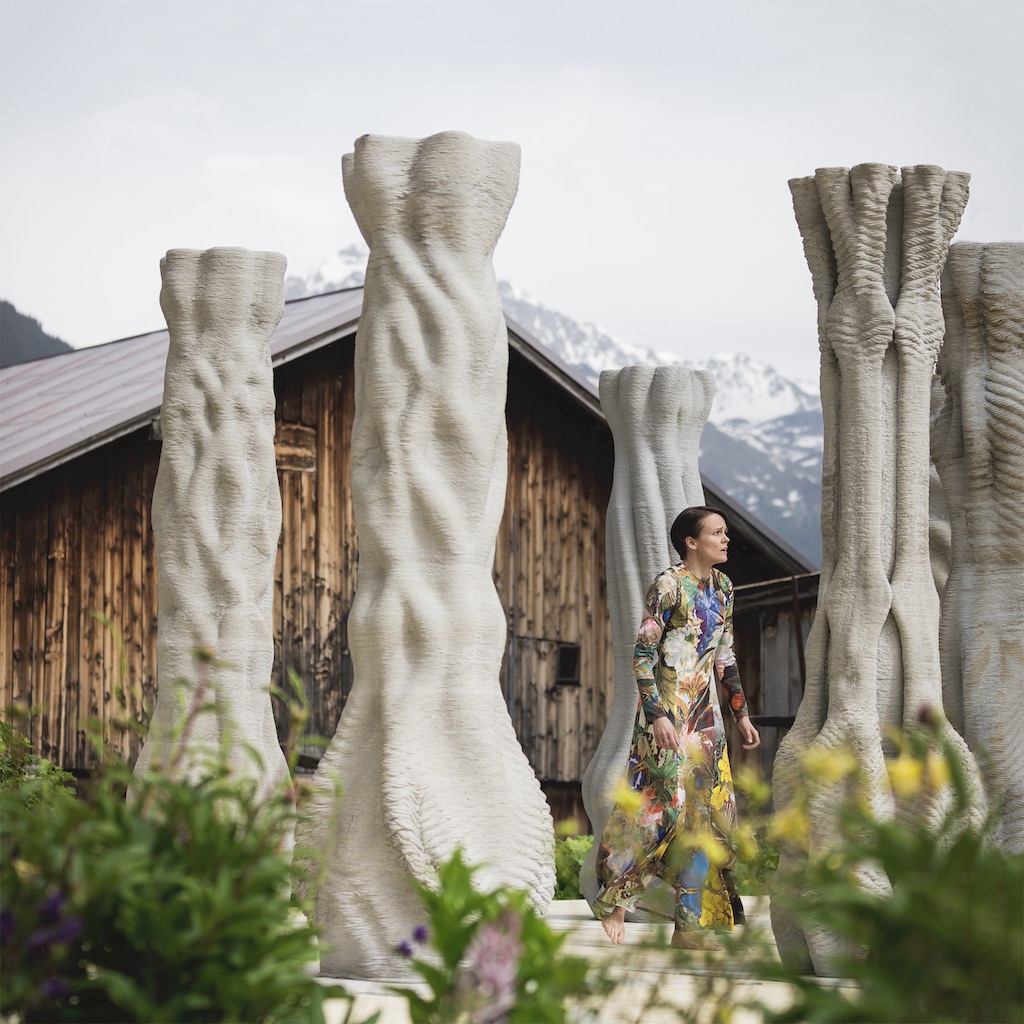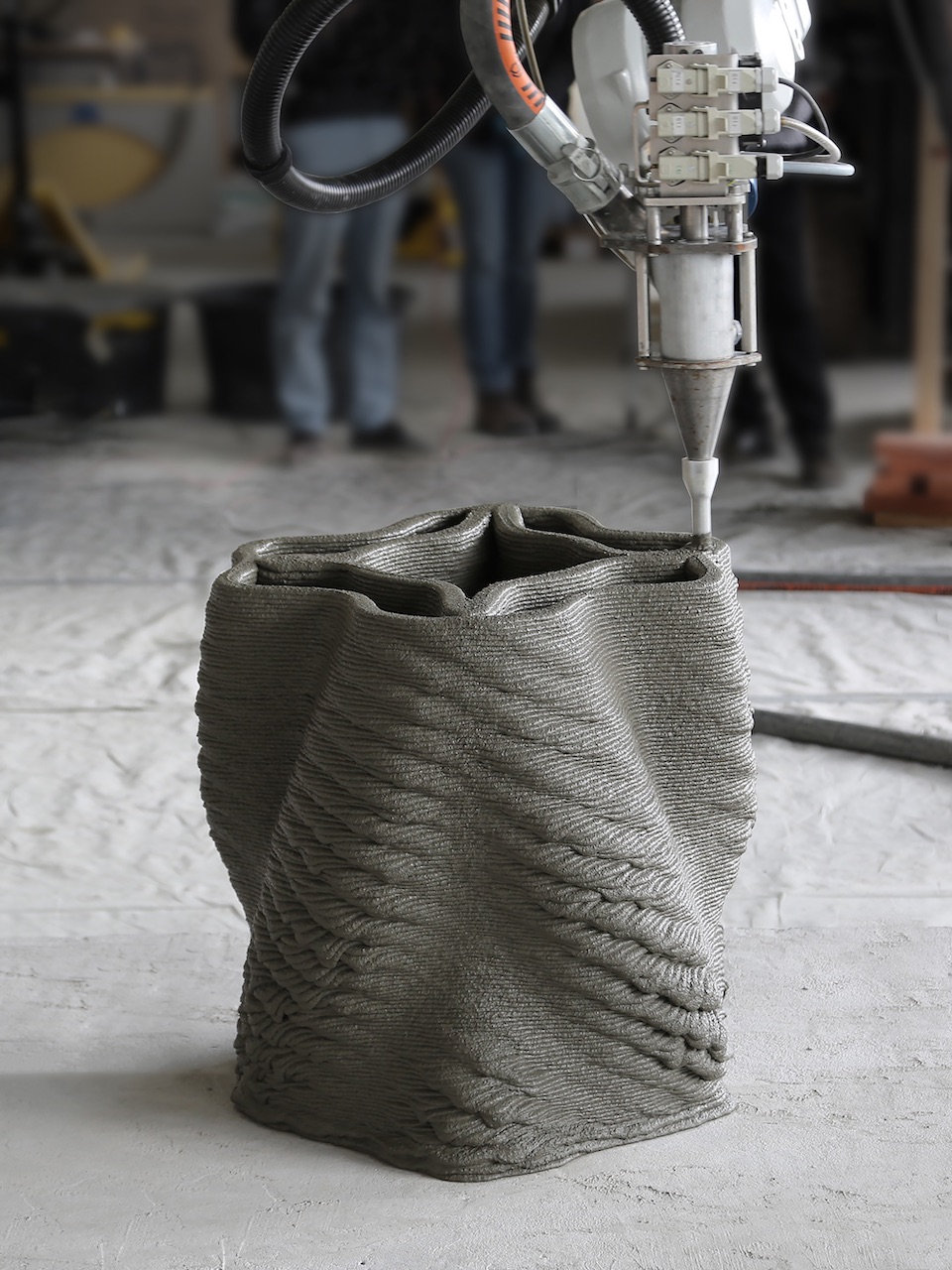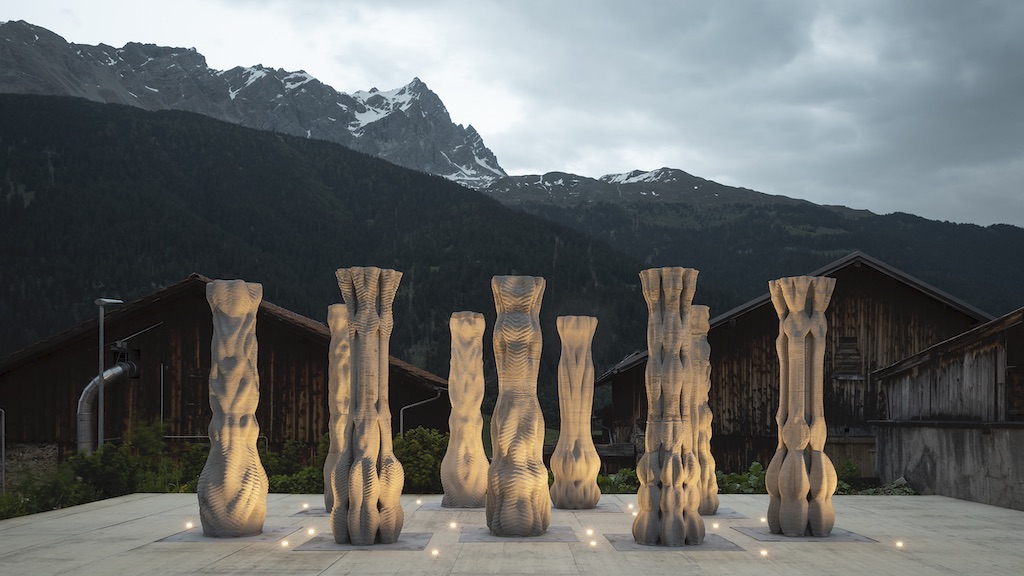hen people think of concrete, they immediately envision apartment blocks with their rectangular uniform-grid facades and minimalist living spaces. Large infrastructures, like concrete dams, highways, tunnels, and bridges might also come to mind often cutting through natural landscapes and creating barriers inside ecosystems. Concrete is, by far, the most utilized and engineered-material in the world. The reasons for its ubiquity in the construction industry comes not only from a seemingly abundance as a resource and the minimal cost of its raw materials, but also from its compressive strength and durability.
A Controversial Material
Economic incentives spur mass productivity and massive amounts of concrete. An estimated 4.1 billion metric tons of concrete worldwide is poured into formworks with a limited scope for taking on new shapes or conserving resources. At present, no material exists that can replace concrete in terms of its long-term efficiency, structural performance, thermal behavior, and formability. However, industry leaders and environmentalists alike concede the unsustainability of concrete. Indeed, the concrete industry is a major CO2 producer; however, problems arise not from the material itself, but from the vast quantities used. Sand, a seemingly endless resource, is much more limited than people think. Raw material suppliers in the construction industry excavate the type of sand suitable for making cement from rivers, lakes, and coastal areas. The nature of how the construction industry currently uses concrete results in over dimensioned structures and massively cast elements.
Shape is Cheap and Material Expensive
As prominent biomaterials scientist, Julian Vincent stated more than 30 years ago, in nature, “shape is cheap and material expensive.” Nevertheless, until recently the opposite held true for the majority of construction techniques. In the case of concrete, intricate forms could be produced at the expense of labor-intensive formworks homogeneously filled without any performance driven shape differentiation.
Computation and digital fabrication tools place architects and the construction industry in a unique position to materialize large-scale complex forms that were previously impossible to conceive just a few years ago, let alone fabricate. Additive manufacturing, with its 3D printing sub-field, promises to enable affordable fabrication of customized building components that incorporate geometric complexity, speed in fabrication, and economy of materials. In this context, “concrete 3D printing” stands out as one of the fastest growing 3D print technologies to date. Printing speeds reach up to 600 millimeters per second and allow continuous printing of a 30 centimeter-diameter hollow cylinder at a height of two meters in under 30 minutes.

Reinventing Creativity Through Digitalization
Controlling concrete as part of a digital fabrication process opens up new opportunities for architects and engineers to create materially lean buildings that eliminate expensive formwork and deliver on the promise of full design customization.
The concrete 3D printing process at ETH Zurich—the Swiss Federal Institute of Technology—is developed as a collaboration between the academic chairs of Digital Building Technologies and Physical Chemistry of Building Materials to investigate tectonic principles for novel building elements. The awareness of using less material instigates novel design opportunities unexplored so far in concrete. By innovating material formulation, fabrication speed, assembly strategies, and structural performance, students research and design components that are hollow, lighter and functionally hybridized. Through an experimental driven methodology, they test ideas and develop one-to-one prototypes that help identify the challenges of upscaling our technology.

Concrete Choreography
As a case study, the “Concrete Choreography” project shows, for the first time, the applicability of the concrete 3D printing processes developed at ETH Zurich for large-scale production. Setting the stage for the Scientifica fair in Zurich, Switzerland and the Origin Festival of Culture in Riom—a small village in the eastern part of Switzerland, architectural students designed, fabricated, and installed nine unique pillars. Testing the limits of our fabrication process, the team record was to continuously 3D print a three-meter-tall (nearly 10 feet) column in just one hour and 50 minutes.
Developing design methods simultaneously with the fabrication parameters, proved that ambitious designs can stimulate technological advancement. Direct 3D printing of structural and non-structural building elements will take the industry one-step closer to a durable and sustainable construction industry. This novel materialization of concrete contributes to a body of work aligned with Vincent’s description of material efficiency inside the natural form. Exploring the potential of complex geometries, encourages the use of novel technologies to aid in the understanding and creation of harmonious urban human habitats with the same level of sophistication and lean material use as those encountered in nature.


a global affairs media network
3D Printing Concrete for a Sustainable Architecture

Concrete Choreography, with a backdrop of the Swiss Alps. Photo by Benjamin Hofer.
January 20, 2020
Today’s architects leverage the lessons of efficiency through complex geometries. Materialized using 3D print technologies, architects create harmonious human habitats that bring the world closer to a sustainable construction industry.
W
hen people think of concrete, they immediately envision apartment blocks with their rectangular uniform-grid facades and minimalist living spaces. Large infrastructures, like concrete dams, highways, tunnels, and bridges might also come to mind often cutting through natural landscapes and creating barriers inside ecosystems. Concrete is, by far, the most utilized and engineered-material in the world. The reasons for its ubiquity in the construction industry comes not only from a seemingly abundance as a resource and the minimal cost of its raw materials, but also from its compressive strength and durability.
A Controversial Material
Economic incentives spur mass productivity and massive amounts of concrete. An estimated 4.1 billion metric tons of concrete worldwide is poured into formworks with a limited scope for taking on new shapes or conserving resources. At present, no material exists that can replace concrete in terms of its long-term efficiency, structural performance, thermal behavior, and formability. However, industry leaders and environmentalists alike concede the unsustainability of concrete. Indeed, the concrete industry is a major CO2 producer; however, problems arise not from the material itself, but from the vast quantities used. Sand, a seemingly endless resource, is much more limited than people think. Raw material suppliers in the construction industry excavate the type of sand suitable for making cement from rivers, lakes, and coastal areas. The nature of how the construction industry currently uses concrete results in over dimensioned structures and massively cast elements.
Shape is Cheap and Material Expensive
As prominent biomaterials scientist, Julian Vincent stated more than 30 years ago, in nature, “shape is cheap and material expensive.” Nevertheless, until recently the opposite held true for the majority of construction techniques. In the case of concrete, intricate forms could be produced at the expense of labor-intensive formworks homogeneously filled without any performance driven shape differentiation.
Computation and digital fabrication tools place architects and the construction industry in a unique position to materialize large-scale complex forms that were previously impossible to conceive just a few years ago, let alone fabricate. Additive manufacturing, with its 3D printing sub-field, promises to enable affordable fabrication of customized building components that incorporate geometric complexity, speed in fabrication, and economy of materials. In this context, “concrete 3D printing” stands out as one of the fastest growing 3D print technologies to date. Printing speeds reach up to 600 millimeters per second and allow continuous printing of a 30 centimeter-diameter hollow cylinder at a height of two meters in under 30 minutes.

Reinventing Creativity Through Digitalization
Controlling concrete as part of a digital fabrication process opens up new opportunities for architects and engineers to create materially lean buildings that eliminate expensive formwork and deliver on the promise of full design customization.
The concrete 3D printing process at ETH Zurich—the Swiss Federal Institute of Technology—is developed as a collaboration between the academic chairs of Digital Building Technologies and Physical Chemistry of Building Materials to investigate tectonic principles for novel building elements. The awareness of using less material instigates novel design opportunities unexplored so far in concrete. By innovating material formulation, fabrication speed, assembly strategies, and structural performance, students research and design components that are hollow, lighter and functionally hybridized. Through an experimental driven methodology, they test ideas and develop one-to-one prototypes that help identify the challenges of upscaling our technology.

Concrete Choreography
As a case study, the “Concrete Choreography” project shows, for the first time, the applicability of the concrete 3D printing processes developed at ETH Zurich for large-scale production. Setting the stage for the Scientifica fair in Zurich, Switzerland and the Origin Festival of Culture in Riom—a small village in the eastern part of Switzerland, architectural students designed, fabricated, and installed nine unique pillars. Testing the limits of our fabrication process, the team record was to continuously 3D print a three-meter-tall (nearly 10 feet) column in just one hour and 50 minutes.
Developing design methods simultaneously with the fabrication parameters, proved that ambitious designs can stimulate technological advancement. Direct 3D printing of structural and non-structural building elements will take the industry one-step closer to a durable and sustainable construction industry. This novel materialization of concrete contributes to a body of work aligned with Vincent’s description of material efficiency inside the natural form. Exploring the potential of complex geometries, encourages the use of novel technologies to aid in the understanding and creation of harmonious urban human habitats with the same level of sophistication and lean material use as those encountered in nature.


